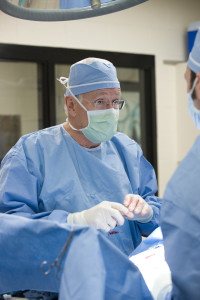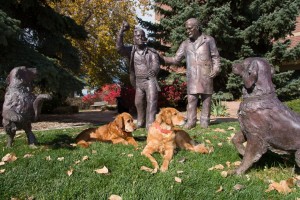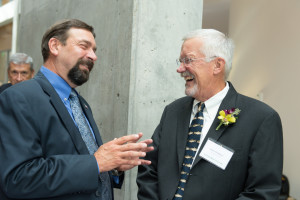Dr. Stephen Withrow, a pioneer in veterinary oncology, received a Founders Day medal from Colorado State University in February, and in his acceptance remarks expressed gratitude for the chance to build a marquee program in animal cancer treatment and comparative oncology.
Colorado State President and Chancellor Tony Frank conferred the honor to mark the university’s 146th anniversary. The Founders Day medal recognizes high-profile friends of CSU who embody its values and its mission in teaching, research and service.
“No matter how he tries to deflect the spotlight, there is no denying that Steve is at the heart of all of the events that shaped the creation of arguably one of the finest cancer centers in the world, and he’s done it with courage, compassion, and a boldness grounded in a firm understanding of the ‘why,’” Frank said.

Building a world-renowned powerhouse
Withrow is a University Distinguished Professor of surgical oncology and was founding director of the CSU Flint Animal Cancer Center; he is transitioning to retirement after 38 years as a veterinary cancer surgeon. He built a world-renowned clinical and research powerhouse that tallies some 6,000 patient visits annually and has helped to establish dogs undergoing cancer treatment as an ideal model for improving cancer care in people.
Among his legacies: Collaborating with physicians to establish limb-saving surgical and chemotherapy treatments for pets and children with bone cancer. Withrow’s contributions are part of the current standard of care for osteosarcoma, in some cases curing and in other cases extending the lives of cancer patients.
Desire for cancer cure a driving force
Meantime, Colorado State’s oncology program has conducted bench-to-patient research and has trained a new generation of cancer specialists, significantly adding to the growth of veterinary oncology and partnerships in human medicine. Driving Withrow’s work is his desire for a cancer cure.
“There’s no such thing as long hours when you think you can mitigate the suffering and pain of animals and kids,” he said at the Founders Day medal ceremony. His family members, friends and colleagues nodded in agreement while seated in a Lory Student Center ballroom.
In his Founders Day remarks, Withrow said he was recruited to CSU by Dr. Wendell Nelson, former director of the Veterinary Teaching Hospital. It was 1978, CSU was in the process of opening its new hospital on Drake Road, and Withrow was an associate professor of surgery at the Western College of Veterinary Medicine, based at the University of Saskatchewan.
“He actually got me to come by Fort Collins from a meeting in Texas,” Withrow said of Nelson. “I’d never heard of Fort Collins, Colorado, but traveling home to Saskatchewan, I stopped in Fort Collins. One thing led to another, and I came with my wife, Sue, and our daughter Cate.”
Here is an extended excerpt of his Founders Day remarks:
I was privileged to come here in 1978. There was almost no oncology in those days in the whole discipline of veterinary medicine, much less CSU. … My first dean was Bob Phemister, who was cool, calm, collected, very diplomatic and gave me hope that, in time, I could develop oncology and move out of the surgery section. My next dean, Jim Voss, was not cool, calm and collected; he was a no-nonsense cowboy with great vision. I was privileged to have Jim as my department head and my dean for over 20 years.
The program really began with Ed Gillette (the late professor was the first full-time veterinary radiation oncologist in the world). Ed was the brains, and in those days I was the brawn. Ed had the intellect to get grants from the National Institutes of Health, and I was in the clinic. Together, even though we had very different styles, we were able to build a program from scratch. …
Through a merger of university, college, department, hospital and private sector, we built a program from one clinician to over 100 people who now occupy the physical space of the Animal Cancer Center, and I’m very proud of that.
I had the privilege of spending a six-month fellowship at the Mayo Clinic in 1975, and it was transformational for me. That’s when, with bone cancer in people, they just started to recognize that maybe you could keep arms and legs on rather than amputate; maybe these kids had better than a 10 percent chance to live more than five years if you gave them chemo. And I understood that the model we had in animals could help people. I learned a philosophy at the Mayo Clinic, too. There was a can-do philosophy, and there’s a whole value system that’s described by the Mayo Clinic. The primary value that they use is, “The need of the patient comes first,” and I firmly believe that.
If you merge that with the Golden Rule, you really have the tenets of how we built the Animal Cancer Center: You care about people, you care about their pets, and you care about transforming that to human health.
I had the privilege with Bob Taylor of doing some fundraising with General Norman Schwarzkopf. One night at dinner, we asked him what made him such a charismatic leader that people would follow him to their death if they needed to. He said, “It’s five words,” and he took my napkin and a Magic Marker and he wrote down, “Take charge. Do what’s right.” I have it framed in my office, and I think that covers a lot of ground. …
I want to give you a quote that I’ve remembered my whole life from Ronald Reagan because I think that the key to the Animal Cancer Center has been good hiring, and getting the best people who are out there and want to collaborate. Ronald Reagan said, “Hire the best people you can, delegate authority, and get the hell out of the way.” That’s what I’ve tried to do. Lynda Reed and Christine Hardy are examples of that.
If you come into the physical plant of the Cancer Center, we have two signs on each floor entering the 10 research labs. One is from Henry Ford: “Coming together is the beginning, keeping together is progress, and working together is success.” The other one is from Alexander Graham Bell: “Great discoveries and improvements invariably involve the cooperation of many minds.”
An area I thought I would never get into, never dreamed of, is the whole area of philanthropy. We’ve been blessed at the Cancer Center to have incredibly grateful clients – well over 10,000 individual gifts from $1 to more than $10 million, from clients who have been well-served by the oncology service in the hospital.
I want to thank Paul Maffey (former executive director of development for the College of Veterinary Medicine and Biomedical Sciences), who really gave me the insight to understand that fund-raising is enjoyable, and it’s great for your program. It’s pretty simple, really. When clients ask you what’s going on, you have to know what you are today, what you want to be tomorrow, and don’t be shy about asking for money. They want to help; they want to believe in you. So it’s actually pretty simple when you get down to it.

I want to recognize one donor in particular, and one family in particular: Hadley Stuart. Hadley was a client of mine, came to CSU with his dog with oral cancer in the ’80s, and entered a National Cancer Institute trial, even though he had all the money in the world to pay for anything he wanted. He wanted to contribute to our knowledge base.
Hadley became a great friend – actually called me at half-time every time the Vikings played the Bears. He knew I’d be at home, and he would call the home number and say, “Do you want some money?” I’d say, “Sure.” He paid for a resident for 10 years in a row, and then he really stepped up, and their cumulative giving exceeds $20 million now. I was privileged to provide hospice care for Hadley when he passed away a few years ago in his home. He got his wish to die in his reclining chair.
His children, Nan and Brett, have continued on the legacy of the Stuart family, and many of us call the Animal Cancer Center the “house that Hadley built.” We’ll be always grateful to Hadley and his family. The strength of the program, like a woven carpet, is not one strand but the strength of the weave, and I firmly believe that. No one person embodies the strength of the cancer center; it’s the team that does it.
The current cancer center is like a five-legged table. We put a high priority on teaching; our primary mission is teaching vet students to be good veterinarians. We continue that core value. Research is huge in our program, linking the clinical program to our basic science.
Our clinical service and clinical trials team is one of the largest in the world, and I want to particularly pick on Sue Lana (clinical oncology service chief), who grew up in our program as a vet student, and we shipped her to Texas for a year and got her back. Now she is running everything. She’s the best den mother you could have and the best person I know at keeping frogs in the wheelbarrow to run the clinical programs.
I’m proud of our outreach program. As a land-grant university, we’re here to help our community, and we do over 3,000 free consultations to clients and veterinarians every year.
And the fifth leg of the table, which is somewhat unique, is the comparative and translational piece of what we do. We’re proud of our relationship with the University of Colorado Cancer Center, and Rod Page (director of the Flint Animal Cancer Center) has strong relationships now.
As you saw in the video, I’ve had a 30-year relationship with Ross Wilkins (Denver physician and founder of the Limb Preservation Foundation) in finding ways that we can keep legs and arms on children and dogs that we couldn’t do 30 years ago and now is commonplace in human medicine.
Lastly, Sky High Hope Camp was transformational for me. It’s what drives me going to work. There’s no such thing as long hours when you think you can mitigate the suffering and pain of animals and kids.

I’m grateful to Tony Frank (CSU president and chancellor) and Brett Anderson (vice president for university advancement). I understand that Brett nominated me for this award, and I know I’m in pretty heavy company with the people Tony mentioned. Tony has been a grand friend since he became a faculty member here in 1993. If you don’t believe in evolution, you should have seen Tony Frank in ’93. There is evolution, and it’s been an honor to be part of this university.
As proud as I am of everything we’ve been able to accomplish as a team at CSU, what I’m most proud of is in the front row here – my family. I’m so privileged to have all 10 folks in town; I’ve got four grandchildren now, who are all healthy and happy, and my whole family is here. I was going to have them stand and give a speech, but they declined. And in particular, my wife, Sue, who’s sitting next to Tony down here. We’ve been married 47 years, hard to believe, and everything I’ve been able to do has been in partnership with Sue. She’s been my soulmate, my primary source of comfort all these years, and I love you very much.
In conclusion, I’m thankful for this honor on behalf of the cancer center. There’s no “I” in “we.” It’s been a team effort. I happened to be at the stern for a while. The paddle is now Page’s, and it’s going forward with great leadership and great support from the institution.
Read about other Founders Day Medal recipients.